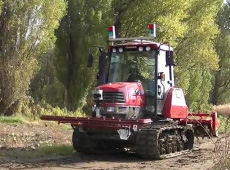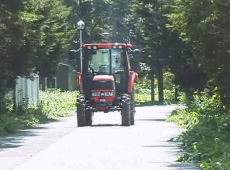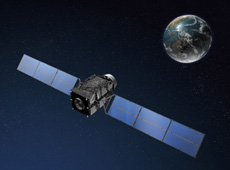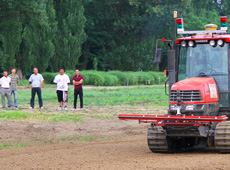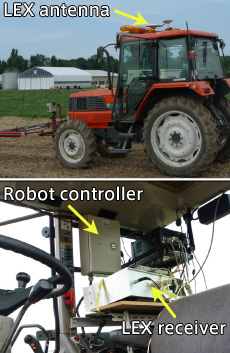Q. MICHIBIKI can also provide positioning in parts of Asia and Oceania. Is there interest in your work in the agricultural sector there?
Agriculture is a major industry in Asia and Oceania, so they are very interested in agricultural technology using MICHIBIKI. This year, Korea and Malaysia ran experiments using a MICHIBIKI signal receiver. In particular, they like MICHIBIKI's capability of enhancing GPS. Enhancing GPS usually requires a base station on the ground, which transmits complementary signals. But if the signals can be transmitted from MICHIBIKI in space, there is no need to build such infrastructure on the ground. This is a great advantage. In the future, it may become possible to export agricultural technology that uses Japanese positioning satellites, and to offer diplomatic support with the technology.
Q. What prompted you to start your research on farm machinery automation using navigation satellites?
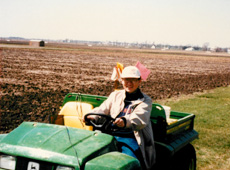
Prof. Noguchi during his time at the University of Illinois (courtesy: Noboru Noguchi)
When I was at the University of Illinois, in the United States, in 1997, research on agriculture automation was already underway there. Farms in the U.S. are so big, you cannot even compare their scale to that of Japanese farms. So they were already using navigation satellites to pinpoint the location of farm machinery. This is how I became interested in the research.
In 1998, there was the first demonstration in the U.S. of an autonomous self-steering tractor. I had a good feeling about the potential of the technology, but farm machinery in the U.S. is very big and very fast, so I thought that, in reality, letting such massive machines run autonomously without drivers would be difficult in terms of safety. But I thought it could work in Japan, considering the smaller size of Japanese tractors.
Q. What is your vision for the future of agriculture with satellite positioning?
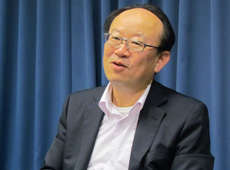
My goal is to make robotic agriculture using remote monitoring technology a reality. This is a part of the project by the Ministry of Agriculture, Forestry and Fisheries, to develop agriculture automation and assistance systems in order to reduce manual farm labor. The idea is that robotic farm machines will operate autonomously in multiple fields, while being monitored from remote offices. These farm machines require no drivers. When they run out of fertilizer, they'll stop, and someone will go and supply it. The plan is to build monitoring rooms where two people can oversee four or more machines.
As the first step, we are looking at a system in which one person is responsible for two farm machines. There is still room for improvement in terms of safety before an autonomous self-steering farm machine can operate without a driver, so for now, to ensure safety, it will be followed by another tractor driven by a farmer, who will monitor the driverless tractor while performing another task as well. This way, the farmer can do two jobs at once, doubling efficiency. In other words, we will start the project as a collaboration between a robot and a person, with the aim of increasing work efficiency, and then we will work on practical applications.
The idea of this two-tractor process was actually suggested by young farmers. With autonomous self-steering farm machines, safety is the biggest concern, because it would be a tragedy if a person got run over. There is no such thing as guaranteed safety even when using a sensor to detect obstacles, and besides, manufactures tend to stay away from machinery that involves such risk. And when we were stuck on this problem, it was the farmers who helped us with an idea. Although we are developing technology that's absolutely necessary for agricultural work, we don't work in the fields, so feedback from farmers is extremely important - there is so much to learn from them. All the more, I would like to make systems that they are satisfied with.
Today, Japan is facing the problem of rural depopulation. If people find something attractive about rural villages, it may bring them back to the land. I hope that my efforts can serve as a motivator for people to become interested in agriculture.
Professor, Research Faculty of Agriculture, Hokkaido University
Prof. Noguchi received his Ph.D. from the Graduate School of Agriculture, Hokkaido University in 1990. He became an associate professor in 1997 and a full professor in 2004. From 1998 to 2001, he was an adjunct professor at the Department of Agricultural Engineering of the University of Illinois, in the United States. Currently, he also serves as a guest professor at China Agricultural University, South China Agricultural University, and Northwest Agriculture and Forestry University. He specializes in agriculture automation, agricultural remote sensing, and IT agriculture.
Automating the Japanese Farm
A Safer World for the Visually Impaired
Seamless Indoor/Outdoor Positioning, Developed in Japan
Building a Better Satellite-Based Positioning System

